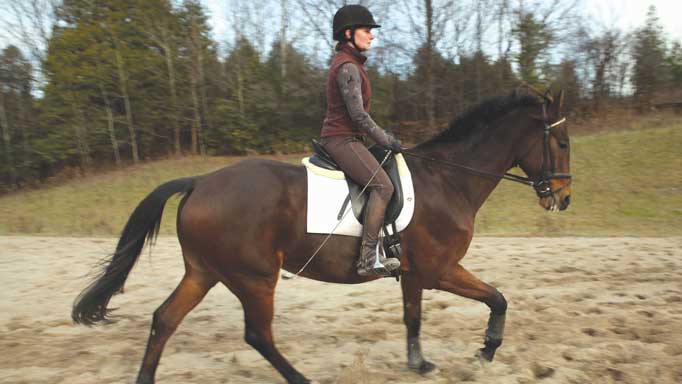Here are Canadian Team member Diana Burnett’s suggestions to improve this gait.
“Some horses have naturally good canters; that’s what I look for when I’m looking at horses. You can improve a trot significantly, but it’s more difficult to improve a bad canter. Horses with poor canters may be heavy on their forehand or have four-beat canters instead of a proper three-beat canter. A poor canter may simply be due to a horse being young and green and without enough strength yet to hold itself in a proper canter. The canter requires him to sit down a bit on his hindquarters, and that’s difficult if he’s not strong enough.
Before you start canter work under saddle, begin at the walk and trot. You want to make sure your horse is listening to your aids and moving forward when you ask. Try some walk-trot and halt-trot transitions to sharpen his responsiveness. Carry a dressage whip and tap him if he doesn’t respond promptly.
Start working on a 20-metre circle, as that will require your horse to engage his hind end. At the walk and trot, leg yield so you spiral gradually inward, making the circle smaller to about 10 metres or less, then leg yield out to increase the size of the circle. You want to have consistent connection with the outside rein and bend the horse slightly inside with the inside rein. Sit on your seat bones, centred in the saddle, and keep your shoulders back. Feel for the rhythm, as it’s your responsibility to regulate it. If he’s heavy in your hands, you might hold the inside rein for a one, two, three count, then soften, then repeat. You want to make a correction, not hold him up; he has to learn to balance himself.
Practice some trot-canter transitions or do some figure-eights, trotting through the middle of the eight, then picking up the opposite canter lead.
You can use trot poles and cavalettis to help improve the canter. Set a line of trot poles or cavalettis [9-12′ apart, depending on your horse’s canter stride] and canter through them. You want the cavalettis set so horse has to be compressing his stride a little and sitting down a bit through the line, not extending and lurching through.
Put four poles or cavalettis on a 20-metre circle set three or four strides apart (diagram 1). That way, your horse is less likely to try to run through as he might on a straight line. I find it’s easier for horses and riders to keep the rhythm on a circle. You might want to start cantering over just one pole on the circle, then two if your horse is not ready to master the four-pole exercise. Canter around the circle, trying to maintain a consistent connection and rhythm so he’s able to canter or jump over the poles without have to chip in or take a long spot.
Another exercise is to set up canter poles or cavalettis around a corner of the ring or arena, set as bounces [9-12′ apart in the centre] in a fan shape (diagram 2). Use blocks to raise one side of the trot poles. This is a fairly difficult exercise, so you might want to start with two poles or cavalettis, then increase up to four or five.
As you canter around a 20-metre circle and approach the cavalettis, your horse will have to be off the forehand and uphill in his canter to successfully negotiate the exercise. This is a tough exercise, so keep sessions brief, as it will take time for your horse to build the hind end strength needed to maintain an uphill canter.”

